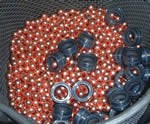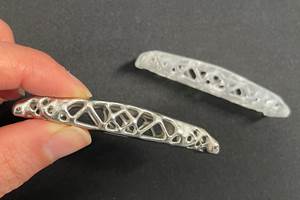Barrel Plating Blues
The following are barrel plating problems that have come up in the recent past...
Barrel plating has existed—in one form or another—since the close of the Civil War. And while the technology has seen some radical improvements in the last 140 years, modern day barrel plating is not without its challenges. Products Finishing asked barrel plating expert Frank Altmayer (Scientific Control Laboratories, Inc.) to address some of the common, real-world challenges associated with barrel plating.
The Problem: Spikes in Cyanide Concentration
The problem is our waste treatment system. This system is new and ever since it was installed we “mysteriously” get spikes in the cyanide concentration coming out of the final discharge. These spikes are sporadic and may be one or two days a week. The rest of the time, the treatment system works fine.
The cyanide treatment system is a two stage destruct unit, using sodium hypochlorite for alkaline oxidation. So far we have tried changing ORP settings, changing the pH in each of the destruct stages up and down and adding a larger excess of hypochlorite, with no success.
My company operates two barrel plating lines. The first is a conventional horizontal barrel plating line, while the second is of the horizontal oscillating (no door) variety. Both lines plate zinc using a cyanide based process, and, while our plating equipment is rather old, we get very good results.
The Solution:
A plant visit, along with a careful analysis of your operations showed that periodically, the conventional horizontal barrel line is over-loaded with work and the oscillating barrel line is then used to plate the over-load. Unfortunately, the over-load consists of cup-shaped parts that create a very high drag-out, as the oscillating barrel line carries these cups into the rinse system without emptying them over the plating tank prior to transfer. A normally rotating barrel would empty the cups over the tank (as is done on your other plating line) and would do a better job of rinsing these parts. We measured the drag-out rate and found it to be about 1.5 gallons per barrel.
As a result of operating the oscillating line on these parts, a large amount of cyanide enters the rinse system after plating. Even a well working waste treatment system can be over-loaded by a spike in cyanide concentration. The systems are designed around 100-500ppm of cyanide, while the spikes were around 2000-2500ppm.
The solution to the problem is to not use the oscillating barrel plating line on cup shaped parts.
The Problem: Damaged Parts
My company performs barrel tin plating on electrical terminals, and we are getting many of damaged parts. The damage seems to be a combination of surface scraping and some of the terminals are twisted by the barrel.
The Solution:
Since tin is a soft metal, it can easily be abraded in a barrel plating operation. The factors to look at include the condition of the electrical contacts, barrel rotational speed and use of ballast.
An examination of the parts under the microscope (see photo) indicated that some severe scraping is going on in at least some of the barrels you are using. The following corrective actions should be considered:
- Change Method of Electrical Contact
The barrels used employ conventional danglers, which can build up in metal to the point of being abrasion sources. Button contacts or rod contacts may be more gentle. - Maintenance of Electrical Contacts
One of the frequently neglected tasks in barrel plating is maintenance of the dangler. As metal builds up on the electrical contacts within a barrel, they develop sharp edges that can cause damage to a moving load. If the electrical contacts have any heavy build-up of metal, this must be removed on a more frequent basis. - Change the Barrel Speed
The barrel speed may cause too much friction between the dangler and parts and between the parts themselves. If possible change to rotational speed of the barrel. By lowering the speed, you may also need to lower the barrel loading. The best combination of barrel loading and speed will have to be determined by trial and error. - Use/Change Ballast
Ballast can be used to keep parts separated during plating, reducing damage from contact with sharp features on the parts and also improving coverage.
If you are not using ballast, try it. Common ballast is copper beads as shown in the photo. This comes in a variety of sizes, and again you need to experiment with both shape and size to arrive at the optimum combination.
The Problem: Barrel Design
We are in the process of designing a new barrel plating line, and we want to use the most effective barrel. We have several designs to choose from, but we’re not sure if there is any real difference in drainage or plating efficiency.
The Solution:
The Illinois Waste Management Resources Center funded a study on the drag-out rates from a variety of barrel designs. A copy of that report is available. The study concluded that there is a significant difference in drag-out rate between barrel designs, with newer designs reducing drag-out rate by 26-49%.
The lower drag-out designs included slotted barrels, mesh/rib types, and even a portable oblique barrel plating system.
The Problem: Plating Solution "Growth"
Our chloride zinc plating solution grows in volume to the point where we are frequently removing solution to avoid over-flow of the plating tank. We have a conventional horizontal barrel plating line.
The Solution:
This is becoming a commonly reported problem. In most cases it is a case of more drag-in than drag-out from the plating solution. The chloride zinc process typically contains a high concentration of wetting agent (surfactant), which lowers the surface tension of the plating solution and results in better drainage of the barrel as the barrel is removed from the plating tank. Since the rinse before the plating tank does not contain any wetter, the barrel does not drain as well before going into the plating tank. Over time, the difference in drag-in volume vs. drag-out volume causes the plating solution to “grow.”
If there is a drag-out rinse, try going into this rinse before you bring the barrel into the plating tank. Since the drag-out rinse will contain some of the wetter, this may solve the problem. Some wetter may need to be added to the drag-out rinse to bring the surface tension closer to that of the plating solution.
If there is no drag-out tank, some wetter may be bled into the last rinse prior to plating. Heating the last rinse before plating may also help, as warm water drains better than cold.
Related Content
Products Finishing Reveals 2024 Qualifying Top Shops
PF reveals the qualifying shops in its annual Top Shops Benchmarking Survey — a program designed to offer shops insights into their overall performance in the industry.
Read MoreHow to Choose Between Sulfate and Chloride-Based Trivalent Chromium
There are several factors to consider when choosing between sulfate and chloride-based baths for trivalent chromium plating. Mark Schario of Columbia Chemical discusses the differences and what platers should keep in mind when evaluating options.
Read MoreTroubleshooting Alkaline Zinc
One of the most common problems that can arise when plating with alkaline zinc is an imbalance of brightener in the solution. In this helpful Ask the Expert article, Chad Murphy of Columbia Chemical discusses how different zinc metal concentrations and brightener concentrations can impact efficiency.
Read MorePossibilities From Electroplating 3D Printed Plastic Parts
Adding layers of nickel or copper to 3D printed polymer can impart desired properties such as electrical conductivity, EMI shielding, abrasion resistance and improved strength — approaching and even exceeding 3D printed metal, according to RePliForm.
Read MoreRead Next
Episode 45: An Interview with Chandler Mancuso, MacDermid Envio Solutions
Chandler Mancuso, technical director with MacDermid Envio discusses updating your wastewater treatment system and implementing materials recycling solutions to increase efficiencies, control costs and reduce environmental impact.
Read MoreA ‘Clean’ Agenda Offers Unique Presentations in Chicago
The 2024 Parts Cleaning Conference, co-located with the International Manufacturing Technology Show, includes presentations by several speakers who are new to the conference and topics that have not been covered in past editions of this event.
Read MoreEducation Bringing Cleaning to Machining
Debuting new speakers and cleaning technology content during this half-day workshop co-located with IMTS 2024.
Read More























